Setting Up a Local Kubernetes Lab I decided to build a new local Kubernetes lab. In the past, I’ve experimented with different providers—Minikube, KIND, and K3s—running both locally and on Raspberry Pi devices. I like trying new tools and tech, so I was on the lookout for a clean and simple way to get a lab up and running. I had a few core requirements:
-
Portable: I wanted the cluster to work anywhere.
-
Simple: I’ve built “Kubernetes the Hard Way” before—this time I wanted something easier.
-
Persistent: KIND doesn’t always recover well after my laptop sleeps or reboots.
After some research and a few YouTube rabbit holes, I landed on Rancher Desktop.
I’d used Rancher Desktop before, mostly for Docker, but I hadn’t taken full advantage of the built-in Kubernetes (K3s). It also comes with native support for Traefik, which is a bonus.
Installation
Installation was easy. The docs were clear, and Rancher supports Windows, macOS, and Linux. I’m on Fedora KDE, and they support dnf, so I had it installed and running in minutes.
Docs: Rancher Desktop Installation Guide
In the preferences panel, I was able to:
Choose the Kubernetes version:
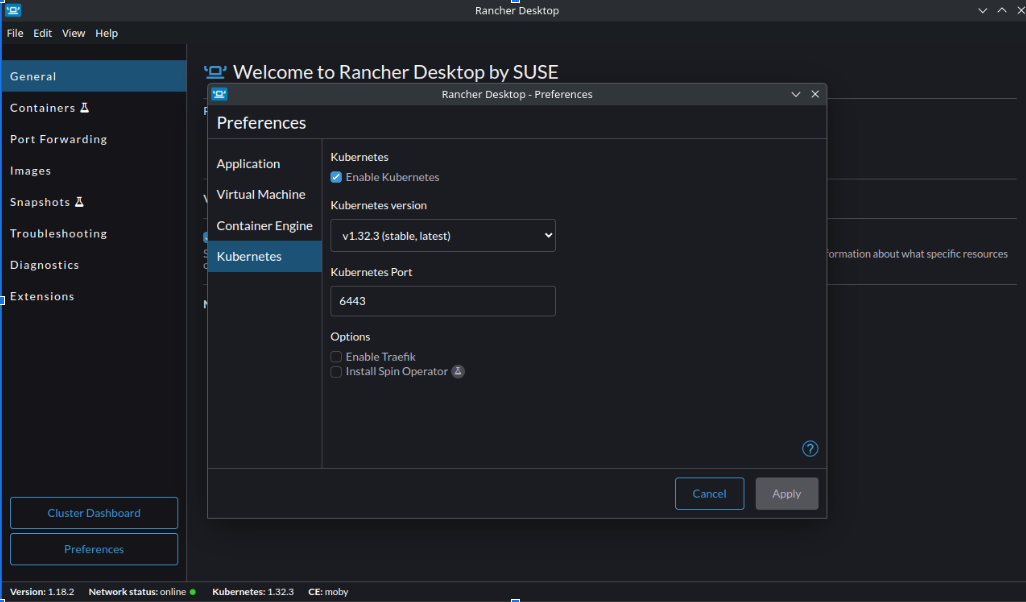
Select between dockerd and containerd:
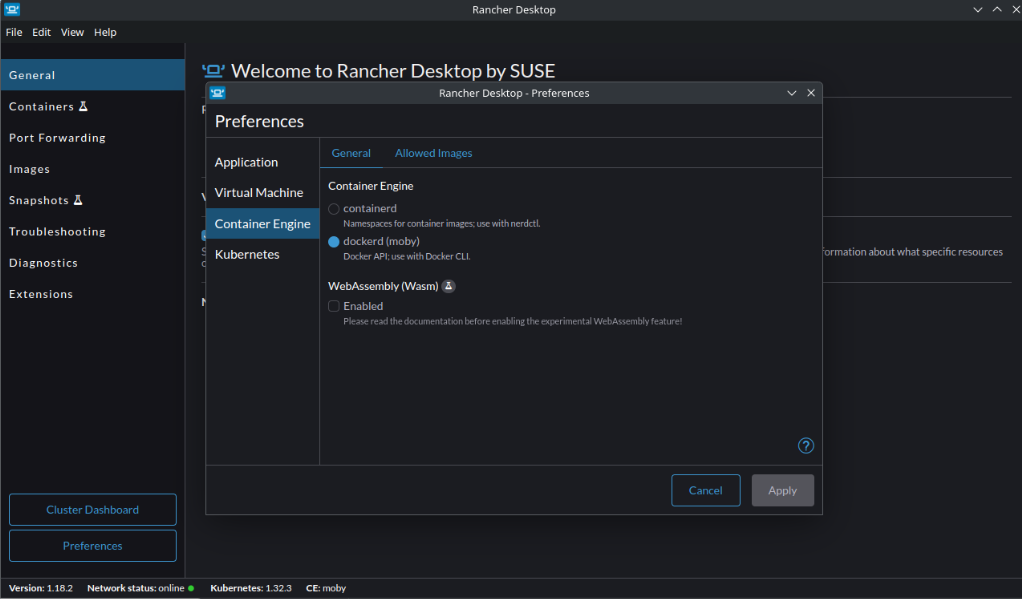
Set CPU and memory limits:
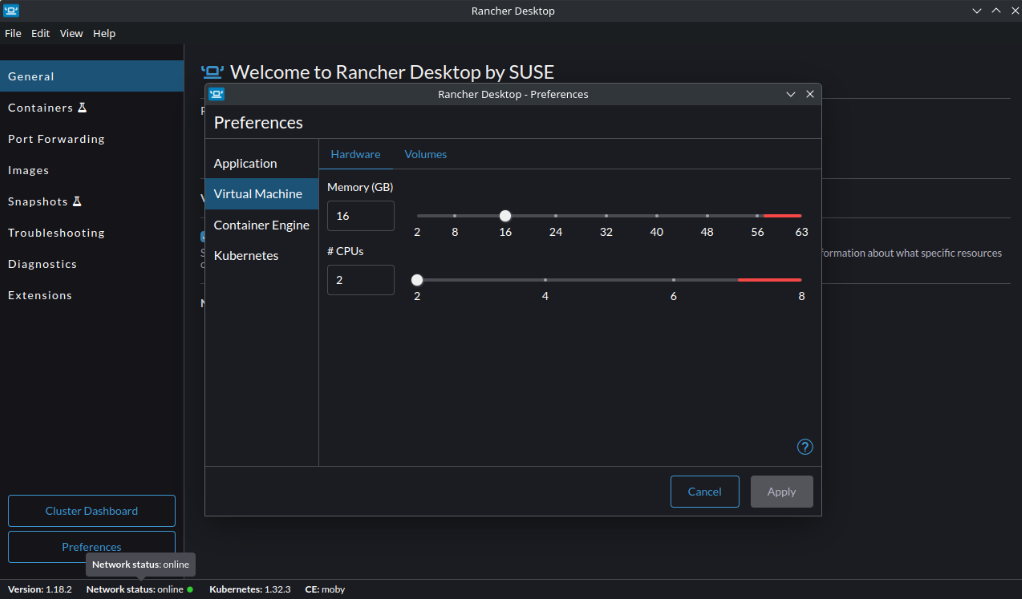
Sometimes, less really is more.
Lab Architecture
This isn’t a home server setup—just a local lab.
My goals:
-
Test Kubernetes tools with minimal overhead
-
Use GitOps for configuration and deployments
-
Keep code in a public GitHub repo
-
Avoid the cloud (no GCP, AWS, Azure)
Even though the cluster is local and not exposed externally, I still want to follow best practices—especially around secret management.
Requirements:
-
GitOps: I’m using ArgoCD. It’s solid, visual, and gets the job done.
-
Public: All my code lives in a public GitHub repo.
-
Simple: I want to pass a variable to an app via a secrets manager.
-
Secure: Secrets come from Bitwarden, using External Secrets.
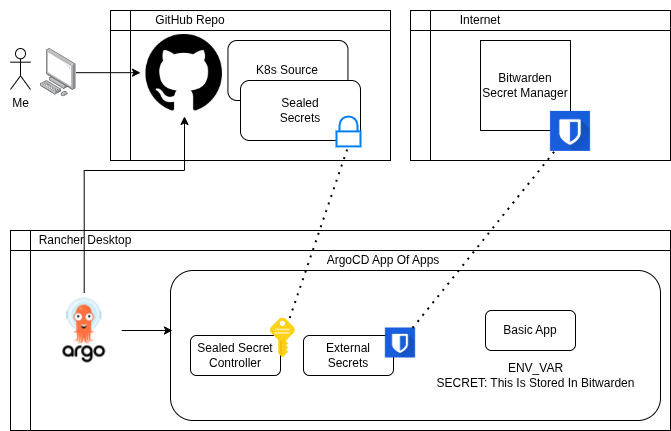
I chose Bitwarden Secrets Manager because it’s free and integrates with External Secrets.
That covers most of my security concerns, but the initial Bitwarden config still needs protection. I tried SOPS with age, but it didn’t go smoothly.
Then I found Sealed Secrets from Bitnami.
“Problem: I can manage all my K8s config in git—except Secrets.” “Solution: Encrypt your Secret into a SealedSecret, which is safe to store—even in a public repo.”
This was exactly what I needed. The Sealed Secrets controller handles encryption/decryption. Only the controller can decrypt the secrets—nobody else, not even me.
That’s fine, since I don’t need to decrypt them locally.
Here’s how to use it:
Step 1: Create the secret:
kubectl create secret generic bitwarden-access-token -n external-secrets \
--from-literal=token=this_is_a_token \
--dry-run=client -o yaml > secret-bitwarden-token.yaml
Step 2: Seal the secret:
kubeseal --controller-name sealed-secrets -f secret-bitwarden-token.yaml > sealed-secret-bitwarden-token.yaml
Here is what it looked like before:
apiVersion: v1
data:
token: dGhpc19pc19hX3Rva2Vu # base64 encoded only, not ideal
kind: Secret
metadata:
creationTimestamp: null
name: bitwarden-access-token
namespace: external-secrets
This is how it looks after its been sealed:
{
"kind": "SealedSecret",
"apiVersion": "bitnami.com/v1alpha1",
"metadata": {
"name": "bitwarden-access-token",
"namespace": "external-secrets",
"creationTimestamp": null
},
"spec": {
"template": {
"metadata": {
"name": "bitwarden-access-token",
"namespace": "external-secrets",
"creationTimestamp": null
}
},
"encryptedData": {
"token": "AgC2hKiONULB6K9/HGB1xXwg3FAoBMmD8lzwORWYMaSTlElswUrNurHHI/USi9xWLynQUk59cn+ATcCO4J/TLH8ELDuKjXTQF28IDM9gEZIbHmxWxZA5ZHsw6yGZVkm12pQbdWk6rhbJOecRgm10YRaqp8pJLXnyIjyzCH8//7Ov3ECkTd1zKIN8Fy6IjLKTW9x/HQDhMLgQQLqUKNvmVQfBnpm2CK7mSo8REPkc+cgVx/VR8rHbaio+LRydCCY9gth2p5HRl/r3zeuRW607SaOxPtw+MWdW8Vz09V18vq6Jg+catoB9uQM4mFumrnaFV8qombdqncDh1ysImfumrlI1mSd00IDK935Wd4/ArqpQhNcct5pfrGl258zwet6V7Oke42HWjvf0Oj020uiWzCxZxiR9lDgVb2HwFoMS6WcINHTJ5L6tYQGbAZHrRIFrrW+UmSESkKXo5gw6iR8/AHCr99Pplnp5f6dx+SLr/xZIxf7SyIH6D62vwe62e6Z4KHpqcA6GtSH7Ttib2szkpgZ5sVsLheh89crjAXNqq4PS+dGgChVFfCgUtC92kFXAq9kZt4t1OnlRWsv7jPSshXfM48evMbsOoWrPx/qH/sP2gAZsmCarY2S01iyrMkKG4gmDWOHlqGDvkgnL19EHn+Ei1ob5UFsvM4SNbfexG7dA/SLSW+BmUlScw5CSiH1aL6Afz2GrN9ygwPbWTmejTfI="
}
}
}
This sealed version is safe to commit to GitHub.
Application Secret Injection
With Bitwarden configured and sealed, I can now have External Secrets inject variables into my app:
apiVersion: external-secrets.io/v1beta1
kind: ClusterSecretStore
metadata:
name: bitwarden-secretsmanager
spec:
provider:
bitwardensecretsmanager:
apiURL: https://api.bitwarden.com
identityURL: https://identity.bitwarden.com
auth:
secretRef:
credentials:
key: token
name: bitwarden-access-token
namespace: external-secrets
bitwardenServerSDKURL: https://bitwarden-sdk-server.external-secrets.svc.cluster.local:9998
organizationID: a3223df9-320f-476d-ae6c-b2ba00541773
projectID: f9f974eb-d57d-4afb-a4c0-b2c8014a05d7
apiVersion: external-secrets.io/v1beta1
kind: ExternalSecret
metadata:
name: bitwarden
spec:
refreshInterval: 1h
secretStoreRef:
name: bitwarden-secretsmanager
kind: ClusterSecretStore
data:
- secretKey: test
remoteRef:
key: "68695b57-b879-4ab3-b2ab-b2c8014d038b" # This is the key in bitwarden that pulls the value
env:
- name: APP_MESSAGE
value: "Test Application"
- name: SECRET
valueFrom:
secretKeyRef:
name: bitwarden
key: test
I check out my application
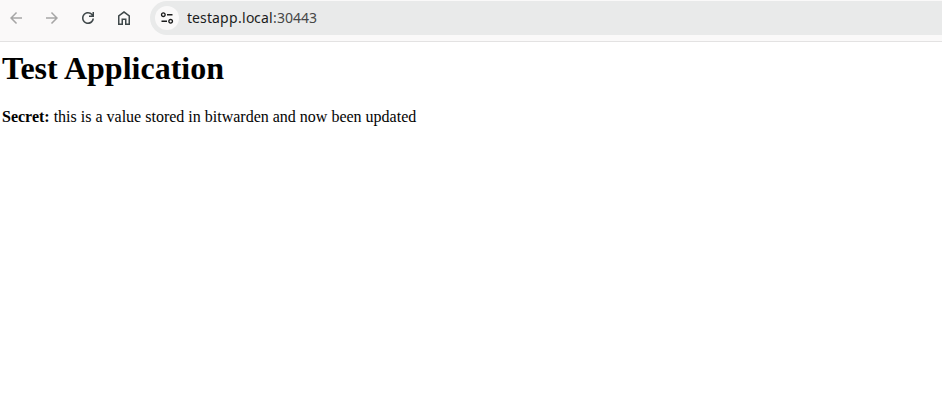
Round Up
-
Decided on Rancher Desktop with K3s for simplicity and portability
-
Set up GitOps using ArgoCD
-
Chose Bitwarden Secrets Manager for managing secrets
-
Used Sealed Secrets to securely store secrets in a public repo
-
Connected it all with External Secrets to inject secrets into my apps
-
This setup gives me a lightweight, local, Kubernetes lab with best practices baked in.



